HISTORICAL ARTWORK BY ARTIST PAUL R. MARTIN III
|
|
Thomas Jefferson once said that the price of liberty is eternal vigilance, which inspired Paul R. Martin’s title of his latest work, "Eternal Vigilance." This exciting new piece of art on the revolutionary history of Yorktown celebrates the 225th anniversary of the American Revolution and the 25th anniversary of the Yorktown Historical Society, which commissioned the print. |
50th ANNIVERSARY OF LAKELAND SCHOOL DISTRICT…
200 YEARS OF SCHOOLING IN THE LAND OF LAKES
Click on photos for enlargements and details or click here to view a Portfolio of Photos
What’s in a name?
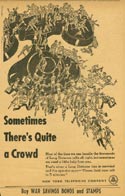 In 1946, the New York Telephone Company needed to establish a new central
office district to meet the growing needs of customers living in northern
Yorktown, Putnam Valley and Cortlandt. While the business heart of Yorktown
still centered around the New York Central railroad station (old Put), the many
lakes in communities along the route six corridor attracted vacationers who were
choosing to live permanently in the bucolic setting.
In 1946, the New York Telephone Company needed to establish a new central
office district to meet the growing needs of customers living in northern
Yorktown, Putnam Valley and Cortlandt. While the business heart of Yorktown
still centered around the New York Central railroad station (old Put), the many
lakes in communities along the route six corridor attracted vacationers who were
choosing to live permanently in the bucolic setting.
The telephone company’s manager at Peekskill, Herbert G. Childs, stated, “The new central office district would include the communities of Mohegan Lake, Shrub Oak, Jefferson Valley, Oregon, Lake Peekskill, Adams Corners, Tompkins Corners, Oscawanna Lake and Roaring Brook Lake.” The name chosen for the district was Lakeland. Mr. Childs stated, “Lakeland is pleasantly and broadly descriptive of this general region, which abounds in lakes and water courses.”
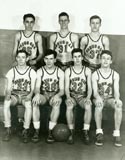 In 1951, three northern school districts of Toddville, Van Cortlandtville and
Shrub Oak voted to merge and became Central School District #1. The new district
included parts of Yorktown, Somers, Cortlandt, Putnam Valley and Carmel, with
Phillipstown joining in 1953. Two years later, a contest was held to name the
new high school being built for the district. One hundred and eighty entries
resulted in a tie for first place. According to Ken Herst, a former Shrub Oak
resident, “I was one of the ones who won the essay contest to name the brand
new school ‘Lakeland’ Junior/Senior high school…I didn’t win the $50
bond, first prize, but did name it Lakeland…after our telephone exchange at
the time, LAkeland 8.”
In 1951, three northern school districts of Toddville, Van Cortlandtville and
Shrub Oak voted to merge and became Central School District #1. The new district
included parts of Yorktown, Somers, Cortlandt, Putnam Valley and Carmel, with
Phillipstown joining in 1953. Two years later, a contest was held to name the
new high school being built for the district. One hundred and eighty entries
resulted in a tie for first place. According to Ken Herst, a former Shrub Oak
resident, “I was one of the ones who won the essay contest to name the brand
new school ‘Lakeland’ Junior/Senior high school…I didn’t win the $50
bond, first prize, but did name it Lakeland…after our telephone exchange at
the time, LAkeland 8.”
 From the earliest entries of the York Town* School Commissioners' Minute Book,
the northwest corner of Yorktown was designated School District #1. When the
Shrub Oak School was built in 1928 (now the Lakeland District Administration
building), it merged the small school districts of Jefferson Valley, Mohegan and
Shrub Oak into Central Rural School District #1. This formed the core of the
Lakeland Central School District, which officially adopted its name in 1973.
Spanning six towns (and two counties), it is still the largest suburban school
district in Westchester County.
From the earliest entries of the York Town* School Commissioners' Minute Book,
the northwest corner of Yorktown was designated School District #1. When the
Shrub Oak School was built in 1928 (now the Lakeland District Administration
building), it merged the small school districts of Jefferson Valley, Mohegan and
Shrub Oak into Central Rural School District #1. This formed the core of the
Lakeland Central School District, which officially adopted its name in 1973.
Spanning six towns (and two counties), it is still the largest suburban school
district in Westchester County.
Early History
 According to the York Town School Commissioners Minutes, in September of 1813
eight school districts were formed, beginning with District #3 “by an Act for
the Establishment of Common Schools, passed June 19, 1812”. One month later an
alteration was made to District #8. The minutes are recorded initially in
haphazard fashion, leading one to believe they were re-copied from another
source. Districts #1 and #2 were formed at some earlier time. The Rev. Silas
Constant wrote in his diary about building a school in Crompond (the heart of
Yorktown before and after the Revolutionary War until the coming of the
railroad) sometime before 1805. The Crompond School later became District #4.
According to the York Town School Commissioners Minutes, in September of 1813
eight school districts were formed, beginning with District #3 “by an Act for
the Establishment of Common Schools, passed June 19, 1812”. One month later an
alteration was made to District #8. The minutes are recorded initially in
haphazard fashion, leading one to believe they were re-copied from another
source. Districts #1 and #2 were formed at some earlier time. The Rev. Silas
Constant wrote in his diary about building a school in Crompond (the heart of
Yorktown before and after the Revolutionary War until the coming of the
railroad) sometime before 1805. The Crompond School later became District #4.
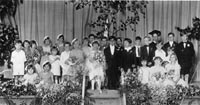
|
 |
 |
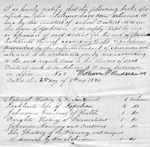 By 1821, there were eleven districts, all within the borders of York Town.
The district boundaries changed regularly, depending on the changing
demographics of the residents. The New York State legislature passed at least
two more Acts, in 1819 and 1827, which were ordered for the support of common
schools. These dealt with, among other things, monetary issues and guidelines
for teachers. They no doubt had an effect on shifting boundaries.
By 1821, there were eleven districts, all within the borders of York Town.
The district boundaries changed regularly, depending on the changing
demographics of the residents. The New York State legislature passed at least
two more Acts, in 1819 and 1827, which were ordered for the support of common
schools. These dealt with, among other things, monetary issues and guidelines
for teachers. They no doubt had an effect on shifting boundaries. 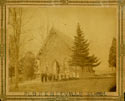 However, the
most important factor for a farmer being included in a certain district was his
proximity to the schoolhouse. There was only one schoolhouse per district; a
one-room building in which ages five through twenty-one were taught. Most
students attended school in winter. In late spring, summer and early fall, they
were needed to help on the farm. Travel was by dirt roads covered by snow and
mud in winter. It was important to be located as close as possible to the
schoolhouse.
However, the
most important factor for a farmer being included in a certain district was his
proximity to the schoolhouse. There was only one schoolhouse per district; a
one-room building in which ages five through twenty-one were taught. Most
students attended school in winter. In late spring, summer and early fall, they
were needed to help on the farm. Travel was by dirt roads covered by snow and
mud in winter. It was important to be located as close as possible to the
schoolhouse.
|
|
 As early as 1815, there are records of residents being moved to school
districts in other towns, no doubt to be closer to a schoolhouse. In 1829, a
schoolhouse was moved from York Town to the land of a Phillips Town resident,
probably to better centralize the schoolhouse.
As early as 1815, there are records of residents being moved to school
districts in other towns, no doubt to be closer to a schoolhouse. In 1829, a
schoolhouse was moved from York Town to the land of a Phillips Town resident,
probably to better centralize the schoolhouse.
This moving across town borders eventually led to the formation of joint
districts.  Joint District #13 was formed March 19, 1839, out of a portion of
Cortlandt Town and York Town.
Joint District #13 was formed March 19, 1839, out of a portion of
Cortlandt Town and York Town.  In June of 1839, the school commissioners of the
towns of Quincy, York and Cortlandt, attempted to form Joint District #1 from
parts of those three towns (Joint District #1 already existed between Quincy
Town and York Town). This proposal was defeated. However, in 1845, Joint
District #19 was formed out
In June of 1839, the school commissioners of the
towns of Quincy, York and Cortlandt, attempted to form Joint District #1 from
parts of those three towns (Joint District #1 already existed between Quincy
Town and York Town). This proposal was defeated. However, in 1845, Joint
District #19 was formed out  of the towns of Putnam Valley (formerly Quincy),
York, Somers and Carmel. On the 1872 map of Yorktown, thirteen districts can be
counted with thirteen schoolhouses well centered within each district. One
district even crossed Croton Lake at Pines Bridge, with the schoolhouse situated
on the south side of the lake.
of the towns of Putnam Valley (formerly Quincy),
York, Somers and Carmel. On the 1872 map of Yorktown, thirteen districts can be
counted with thirteen schoolhouses well centered within each district. One
district even crossed Croton Lake at Pines Bridge, with the schoolhouse situated
on the south side of the lake.
 District schools went up to the 8th grade, or age twenty-one, whichever came
first! Only the wealthier families sent their children on to secondary school.
Northern Yorktowners went to Peekskill (Oakside school), while the rest
generally went to Tarrytown. Others attended private academies such as Lake
Mohegan Military School.
District schools went up to the 8th grade, or age twenty-one, whichever came
first! Only the wealthier families sent their children on to secondary school.
Northern Yorktowners went to Peekskill (Oakside school), while the rest
generally went to Tarrytown. Others attended private academies such as Lake
Mohegan Military School.
 This continual shifting, combining, and re-grouping of school districts
continued right up to 1927. Out of twelve school districts in and around
Yorktown, three became Central Rural School District #1 (Lakeland) and nine
became Central Rural School District #2 (Yorktown). Finally, a school for grades
K-12 in District #2 was built in 1923, followed by the Shrub Oak school in 1928
for School District #1.
This continual shifting, combining, and re-grouping of school districts
continued right up to 1927. Out of twelve school districts in and around
Yorktown, three became Central Rural School District #1 (Lakeland) and nine
became Central Rural School District #2 (Yorktown). Finally, a school for grades
K-12 in District #2 was built in 1923, followed by the Shrub Oak school in 1928
for School District #1.
Lakeland History
 Prior to merging with Shrub Oak in 1951, Toddville and Van Cortlandtville
were small regional schools. The Toddville School was built in 1920. It is now
rented to BOCES. The Van Cortlandtville School was originally a mid-1800s
one-room schoolhouse, which was abandoned in 1935 when the new school was built.
It served as a kindergarten for Central School District #1 until 1972. It now is
a living history museum known as the Little Red Schoolhouse. The second Van
Cortlandtville School was opened in 1935 and now serves as the Cortlandt Town
Hall. Today, the Van Cortlandtville School is located at the former Lakeland
High School building on Route 6 in Mohegan Lake, which was built in 1954.
Prior to merging with Shrub Oak in 1951, Toddville and Van Cortlandtville
were small regional schools. The Toddville School was built in 1920. It is now
rented to BOCES. The Van Cortlandtville School was originally a mid-1800s
one-room schoolhouse, which was abandoned in 1935 when the new school was built.
It served as a kindergarten for Central School District #1 until 1972. It now is
a living history museum known as the Little Red Schoolhouse. The second Van
Cortlandtville School was opened in 1935 and now serves as the Cortlandt Town
Hall. Today, the Van Cortlandtville School is located at the former Lakeland
High School building on Route 6 in Mohegan Lake, which was built in 1954.
 The Shrub Oak school, now serving the Lakeland administration, was the third
one in the hamlet. The first was built prior to 1842 and was located next to the
old Methodist church, across from the cemetery. By 1890, it was in deplorable
condition. It was sold to a local farmer as a barn and a new school was built.
According to a 1972 interview with the late Charlotte Martens Lee, who began
school in Shrub Oak in 1903, some children came from as far away as Barger
Street. By 1905, the school had become overcrowded. It was a one-room building
with approximately fifty registered students. To relieve the overcrowding, the
lower four grades (including Charlotte’s) were moved to the basement of the
Odd Fellows Hall (later Stark Hardware) for one year. According to Charlotte, it
was a miserable, dark, small place. The following year they attended school
above Darrow’s store, which was a store and Post Office on Old Route 6. By
that time they had enlarged the schoolhouse to two rooms, and added a large
entryway and boys and girls coatrooms. This school remained in use until 1928
when it was sold to Irene Rich as a private residence.
The Shrub Oak school, now serving the Lakeland administration, was the third
one in the hamlet. The first was built prior to 1842 and was located next to the
old Methodist church, across from the cemetery. By 1890, it was in deplorable
condition. It was sold to a local farmer as a barn and a new school was built.
According to a 1972 interview with the late Charlotte Martens Lee, who began
school in Shrub Oak in 1903, some children came from as far away as Barger
Street. By 1905, the school had become overcrowded. It was a one-room building
with approximately fifty registered students. To relieve the overcrowding, the
lower four grades (including Charlotte’s) were moved to the basement of the
Odd Fellows Hall (later Stark Hardware) for one year. According to Charlotte, it
was a miserable, dark, small place. The following year they attended school
above Darrow’s store, which was a store and Post Office on Old Route 6. By
that time they had enlarged the schoolhouse to two rooms, and added a large
entryway and boys and girls coatrooms. This school remained in use until 1928
when it was sold to Irene Rich as a private residence.
 In 1958, Central School District #1 opened three additional elementary
schools: George Washington, Thomas Jefferson (the third school building located
on Gomer Street in Jefferson Valley) and Abraham Lincoln, now Lincoln-Titus. In
1965, the current Lakeland High School opened in Shrub Oak. Copper Beech Middle
School opened in 1966 where the prior Copper Beech Camp was located. Benjamin
Franklin Elementary School followed in 1968. Walter Panas High School was built
in Cortlandt in 1972 to alleviate overcrowding in the high school. It was named
for the first principal of the district, Walter Panas, who retired in 1969.
Finally, in 1973 the district was named “Lakeland”.
In 1958, Central School District #1 opened three additional elementary
schools: George Washington, Thomas Jefferson (the third school building located
on Gomer Street in Jefferson Valley) and Abraham Lincoln, now Lincoln-Titus. In
1965, the current Lakeland High School opened in Shrub Oak. Copper Beech Middle
School opened in 1966 where the prior Copper Beech Camp was located. Benjamin
Franklin Elementary School followed in 1968. Walter Panas High School was built
in Cortlandt in 1972 to alleviate overcrowding in the high school. It was named
for the first principal of the district, Walter Panas, who retired in 1969.
Finally, in 1973 the district was named “Lakeland”.
 As demographics change, the Lakeland Central School District continues to
change with it, just as the earliest school districts had to change, in order to
provide the best education possible for the children of northern Westchester and
southern Putnam Counties.
As demographics change, the Lakeland Central School District continues to
change with it, just as the earliest school districts had to change, in order to
provide the best education possible for the children of northern Westchester and
southern Putnam Counties.
* The name “York Town” was used in early records.
Written by Linda L. Kiederer
Photos and York Town School Commissioners' Minute Book records courtesy of the
Town Clerk
Information on the Lakeland School District history was taken from its 50th
Anniversary calendar.
The Yorktown Historical Society updates the home page with seasonally appropriate articles and information. Click here to read our past issues.